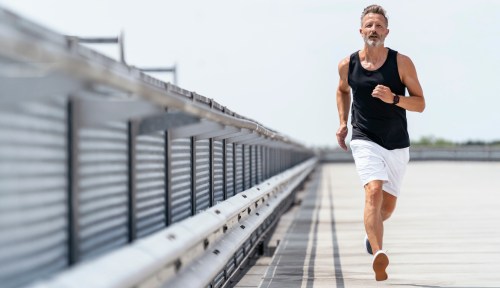How Pilates Pushed One 66-Year-Old Triathlete To Run the Fastest Miles of His Life
Pilates for older runners is important for avoiding injuries and keeping your body balanced. Here's how it helped one triathlete get faster.

Joseph Gaviola, 66, has been competing in triathlons for 25 years, and he has no plans of stopping any time soon—especially because now, he’s running faster than he ever has in his life. Thanks to Pilates, Gaviola is pacing at a 7-minute mile, to be exact.
According to 2018 study, runners’ paces start to decline by a linear rate of one percent each year between the ages of 40 and 70 (and this number rises to a 1.5 percent decline when they hit their late 70s). While this may not sound like a lot, for someone like Gaviola—whose goal is to rank in the top 100 at the USA triathlon—it makes a big difference. Last year, he realized that the intensive training that he’d put his body through over the last quarter-century had started to take its toll. “I found that I was getting slower, and biking and running so much was compressing my joints and tendons,” he says. “So I wanted to find a way to create greater mobility and extend my career.” This, he explains, is how he ended up supplementing his triathlon training with Pilates.
Pilates can help enhance a runner’s performance at any age, but it’s especially helpful for older athletes like Gaviola, who have been putting significant wear and tear on their bodies throughout their lifetimes. “There has to be a complementary training to counterbalance the effects of a high-endurance and repetitive sport,” says Ashley Patten, the Hamptons-based Pilates instructor who Gaviola has been working with for the past year. “The training that a triathlon takes has a lot of repetition, so it’s really important to do a kind of exercise to counteract that, and that’s where Pilates comes in. It’s the perfect balance of stretching and strength, and gives you a workout in which no muscle is overtrained or undertrained, which helps to give your body the balance it needs for all of those repetitive motions.”
This, Patten explains, can help to prevent running injuries as your body ages. “Ultimately, injuries happen because of compensation, which is what occurs when you have imbalances in your body,” she says. “When something is too strong, something else is going to compensate, and you’re going to get hurt. Because of this, you don’t just need ‘strong’ muscles—you need a balance of strength as well as stability and mobility.”
Pilates is known for working the smaller muscles that tend to be ignored in high-intensity training, which is what makes it such a helpful practice to counterbalance racing. “Our big muscles love to work, and it’s easy for them to work,” says Patten. “But you can’t just train one part of your body—you have to train the full body. Everything is intrinsically connected, so if you only work one muscle, you’re missing out on the benefits of working everything.”
In order to really achieve that balance, you need a combination of mobility, stability, stretching, and strengthening—all of which Pilates workouts offer. “In most exercises, one part of your body is stable while another part is moving, so you’re really working your stability and mobility at the same time,” says Patten.
After working with Patten for eight months to improve his flexibility, core strength, and muscle elasticity, Gaviola has seen these benefits pay off in his own triathlon training. “It’s made me stronger, and at the same time, it’s made me faster,” he says. “My gait elongated, I was stronger on hills, and my core felt stronger. I’m faster than I’ve ever been in my life, which is pretty crazy at 66 years old.”
And it’s not just his running that’s improved—he’s become a better triathlete overall and has been on the podium for every race he’s run in the last year. “My swimming and biking have also gotten better,” he says. “I found that with enhancing my overall fitness with Pilates, I’ve strengthened areas of my body that had been neglected in my years of training.”
Ultimately, all of this has given him the confidence he needed to continue to push toward his goals—something he plans to continue to do for many years to come. “I feel stronger, which has made me more confident, and that’s been a big part of it,” he says. “My joints are feeling good, my whole body is feeling good, and I’m feeling good emotionally and psychologically. And now, I’m faster because of it.”
Want to work some Pilates into your own running routine? Follow along with the video below.
Oh hi! You look like someone who loves free workouts, discounts for cutting-edge wellness brands, and exclusive Well+Good content. Sign up for Well+, our online community of wellness insiders, and unlock your rewards instantly.
Sign Up for Our Daily Newsletter
Get all the latest in wellness, trends, food, fitness, beauty, and more delivered right to your inbox.
Got it, you've been added to our email list.










